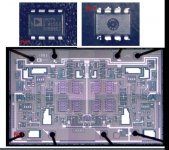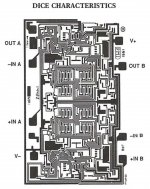Recently, I purchased a DAC from a China source~ Weiliang Audio, opened the case from DAC, the audio IC is OP275. However, after a min. of ear hearing test; it's so dark, dry, un-open, something went wrong.
After I took off that OP275 from DIP socket, and replaced it with a TL082, NE5532 for trial separately, the sound hearing went normal.
I doubt this OP275 is a counterfeit one. Through a help from a friend in Chem. lab, disassemble of the cap and found the wafer chip was made in 1993 by ADI.
OP275 was announced around YR2004, so that de-cap wafer mark should be another chip for instead. Trace back history from Google, during that period, it should be AD822 starting promotion period.
When the joy of making audio equipment upgrade, and found audio marketing purpose is going to be remark cheating, then no value worth at all.
After I took off that OP275 from DIP socket, and replaced it with a TL082, NE5532 for trial separately, the sound hearing went normal.
I doubt this OP275 is a counterfeit one. Through a help from a friend in Chem. lab, disassemble of the cap and found the wafer chip was made in 1993 by ADI.
OP275 was announced around YR2004, so that de-cap wafer mark should be another chip for instead. Trace back history from Google, during that period, it should be AD822 starting promotion period.
When the joy of making audio equipment upgrade, and found audio marketing purpose is going to be remark cheating, then no value worth at all.
Attachments
I bought opa275 a long time ago, maybe more than 20years.
I am surprised that you state they were introduced in 2004.
The rev C datasheet says rev B came in '03, but does not confirm the original release.
I am surprised that you state they were introduced in 2004.
The rev C datasheet says rev B came in '03, but does not confirm the original release.
I have experienced this 1st hand.
The true op-275 draws only 5-8ma and the fake ones draw more.
I contacted my seller in China and they admitted it was fake and refunded me.
So now I only buy op-275 from authorized US distributors like Mouser, Newark, Digikey etc.
The true op-275 draws only 5-8ma and the fake ones draw more.
I contacted my seller in China and they admitted it was fake and refunded me.
So now I only buy op-275 from authorized US distributors like Mouser, Newark, Digikey etc.
I have 10pcs of original OP275 unused and gathering dust because I do not like the sound of it at all. Too dark, soft, lacking detail, smeared. All are originals bought from Farnell. So, if you hear the same as I do, it just might be originals.
Interesting.
I found some versions of the datasheet (for example this one on p.3)
OP275 pdf, OP275 description, OP275 datasheets, OP275 view ::: ALLDATASHEET :::
showing a die layout that looks quite similar to the OP's picture in post #1.
I found some versions of the datasheet (for example this one on p.3)
OP275 pdf, OP275 description, OP275 datasheets, OP275 view ::: ALLDATASHEET :::
showing a die layout that looks quite similar to the OP's picture in post #1.
There should be a die ID on the die itself. You should be able to see it under a microscope. Now that you have it de-capped anyway you might as well poke around a bit. 🙂
Tom
Tom
If your chip has been produced in 1993 you obviously bought some recycled stuff. This is quite common now with cheap chinese offers. If you buy on the bazar, you get what you payed for.
You would not be able to tell the production date from the die markings. All the die markings are saying is that the layout was designed in 1993 so it's safe to assume the chip started production around then. The production date can often be deduced from the package markings.
Tom
Tom
I have scanned the Rev. 0 datasheet for the OP-275, and the document numbering on the back ends with 4/92. There's no official date in the datasheet, but I assume that it's from 1992. I remember buying some in the mid 90s, so 1993 definitely seems plausible. The datasheet also has a picture of the top metallization, and there's a 1991 PMI copyright marking. This metal sorta looks like your de-capped chip, so I've attached a slightly foggy clipping of that metal photo here.
Attachments
The opend chip has ADI marking and the triangular opamp symbol AD often uses.
#1442Y while the PMI chip has 1442Z. Layout sames very similar.
#1442Y while the PMI chip has 1442Z. Layout sames very similar.
ADI bought PMI around that same time. I guess they altered the masks, perhaps just to touch up the company branding, or perhaps to fit the device to available Analog wafer processes. At any rate, this shows that the OP275 was originally a PMI design that was moved to Analog after they acquired PMI. So, the de-capped die shown in the initial post was a post-PMI manufacture OP-275, that seems to look essentially like the original PMI OP-275 chips.
I've personally never been a fan of the OP-275, but still, the taxonomy of that chip is very interesting to me. 🙂
I've personally never been a fan of the OP-275, but still, the taxonomy of that chip is very interesting to me. 🙂
Many people think that if chip is "advanced" and expensive, it must sound excellent. The reality is somewhat different than that.
I've only read positive comments everywhere else about the op-275 and my personal experience with it is that it sounds beautiful too. Though I'm not an 'audiophile' so it's very subjective.I've personally never been a fan of the OP-275, but still, the taxonomy of that chip is very interesting to me. 🙂
I do like that it has a +/-20v Vcc for about a +/- 18v output swing.
Would you care to elaborate on your reasons for not being a fan?
It's so old that it should be authentic. FYI, ancient opamps cost much higher than modern opamps in China.
I guess most fake opamps would just use the cheapo JRC4556 or JRC4558 instead.
I guess most fake opamps would just use the cheapo JRC4556 or JRC4558 instead.
I've only read positive comments everywhere else about the op-275 and my personal experience with it is that it sounds beautiful too. Though I'm not an 'audiophile' so it's very subjective.
I do like that it has a +/-20v Vcc for about a +/- 18v output swing.
Would you care to elaborate on your reasons for not being a fan?
Its distortion is not all that low, noise isn't that high, but it's not all that low either, and the DC offset and input bias / offset are not particularly low either. It isn't awful, but it's not cheap and it doesn't do much that some other amp does better, usually at lower cost. On the other hand, if you like the way it sounds, then you're welcome to use it. I'm more into 'colorless' amplifiers, so it doesn't fit any sweet spots for me.
For similar input characteristics, a 5532 seems to be a better choice, and if I want to spend almost as much as an OP275, I'll gladly take an LM4562.
I still keep a bunch of PMI OP275GS. They were certainly manufactured long before 2000. I believe one exotic DAC from dCS used OP275 as buffer many years ago.
Last edited:
same chip layout or ancient looks doesn't mean it isn't fake.
few years ago they copying package and marking, but today some fake copy the the whole chip layout.
you need to ask the seller about the quality. sometimes there are high quality fakes, bad (fail manufactured) original, or totally fakes and remarking.
I bought many type opamps from china continuously, and you need to ask the seller, really its not mouser or digikey so you need different way to buy.
few years ago they copying package and marking, but today some fake copy the the whole chip layout.
you need to ask the seller about the quality. sometimes there are high quality fakes, bad (fail manufactured) original, or totally fakes and remarking.
I bought many type opamps from china continuously, and you need to ask the seller, really its not mouser or digikey so you need different way to buy.
After receiving fake op-275 from Asia, I talked to AD about how to easily determine if it was fake or not.
I discovered the fake by the excess current draw.
AD said it's hard to know without serious lab tests. So they advised me just to be sure I only ever buy from any authorized US distributor.
Mouser
Newark
Digikey .... etc
But they also suggested that Rochester Electronics was a good source of their products because they buy production over run or excess parts but ALL are REAL ADI parts.
https://buy.rocelec.com/buy/search?q=op275gpz&manufacturers=&order=partasc&p=1
I discovered the fake by the excess current draw.
AD said it's hard to know without serious lab tests. So they advised me just to be sure I only ever buy from any authorized US distributor.
Mouser
Newark
Digikey .... etc
But they also suggested that Rochester Electronics was a good source of their products because they buy production over run or excess parts but ALL are REAL ADI parts.
https://buy.rocelec.com/buy/search?q=op275gpz&manufacturers=&order=partasc&p=1
- Status
- Not open for further replies.
- Home
- Amplifiers
- Chip Amps
- OP275 dual OPA, might be many fake source originated in China

